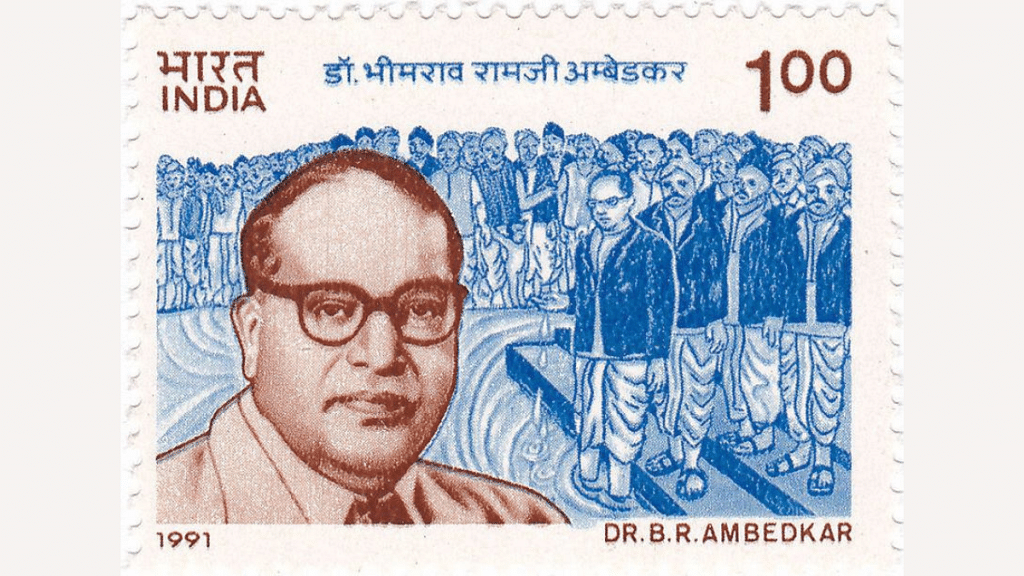B.R. Ambedkar made his debut in the world of stamps in 1966. When the first stamp was released, his views were described as “extreme”. It took nearly four decades for the Indian government to shed its anxiety about one of the foremost founders of the nation. A unique exhibition in New Delhi, called ‘Baba Saheb: An Extraordinary Philatelic Journey’, opened this week at the India International Centre. It offers a new lens to the emerging Ambedkar scholarship and iconography besides statues, movies, books and memorials.
Although curator and Azim Premji University professor Vikas Kumar had started collecting stamps in 1984, it was not until March 2020 that he actively began curating postage and imprinted stamps on Ambedkar for an exhibition. Categorised into three phases — Phase I (1966-1991), Phase II (1992-2010), Phase III (2012-2022) — the exhibition was inaugurated on 7 June. It traces Ambedkar’s journey from “enfant terrible of Indian politics” to the third-most important philatelic figure of the country.
A decade after Ambedkar’s demise, the Indian Posts and Telegraphs Department (P&T Department) honoured him with a commemorative stamp on his 75th birth anniversary in 1966. While the brochure recognises his involvement in social movements “to remove the disabilities from which the Harijans were suffering” and his role in “India’s transition from a colony to a Republic”, it describes him as a leader who “often appeared” to take “extreme positions on social and political matters.” Interestingly, the calendar of commemorative stamps that the P&T Department used to release in advance did not mention any stamp on Ambedkar in the 1966 calendar.
Also read: Lights, camera, caste – An Ambedkar photo made it to Bollywood after 38 yrs of independence
A prism to State attitude
Stamps are an important prism to study history and, in this case, the Indian State’s response and attitude toward Ambedkar, said Vikas Kumar. “The growth of Ambedkar stamps is more an outcome of people’s aspiration and public pressure from the ground up rather than the government’s own initiative,” he mentioned.
Professor Kumar had to dive deep into the archives of India’s postage stamps from the mid-20th century. However, the “official archives do not have much to offer”, compelling Kumar to connect with as many stamp dealers and individual collectors as possible.
Come the 1990s, Ambedkar was invariably included in postal archives, said Kumar, because, by then, “he had emerged as a major figure in the country.” He became “someone you wanted to be connected with,” he added. Babasaheb had begun to be quoted on postal stationery. The inland letter card issued in 1993 carried the following quote sponsored by the Ministry of Social Welfare: “Bandhutva loktantra ka hi dusra naam hai (Fraternity is another name for democracy).”
Definitive stamps are printed for daily use in mass numbers and continue to be printed till a new series comes out. Commemorative stamps are limited edition stamps released on special occasions.
Following Ambedkar’s maiden commemorative stamp, the P&T Department had issued two more — in 1973 (125th birth anniversary) and 1991 (birth centenary). However, it was not until 2001 that he was inducted into the postal pantheon of figures honoured with definitive stamps by Dalit leader Ram Vilas Paswan. The Atal Bihari Vajpayee government released special definitive stamps on Sardar Vallabhbhai Patel, Subhas Chandra Bose and B.R. Ambedkar. Until then, only Mahatma Gandhi and Jawaharlal Nehru had featured on these stamps. And Kumar attested to that when he commented on the collection at IIC: “I can fill more than five floors of stamps on Mahatma Gandhi and more than two floors with stamps on Nehru, but this is all there is on Ambedkar.” Two other definitives on Ambedkar were issued in 2009 and 2016.
Also read: The Ambedkar musical is not just about Babasaheb, it’s a nod to Kejriwal’s politics too
Stamps — smallest battlefield in the world
Dr Gopal Guru, the editor of Economic and Political Weekly who inaugurated the IIC exhibition pointed out that stamps are “created, produced not out of innocence.” He added, “As the stamps suggest, Ambedkar was a late comer in the philatelic world. There is some kind of political background behind conceptualising these stamps.” Hence, studying the State’s response to the public interest through the lens of the postage stamps and curating them become all the more “significant”.
Ambedkar is one of the most prominent leaders in Indian history who has been celebrated, documented, resurrected (on-screen) and commemorated in different art forms across the country and beyond. Earlier this year, the Delhi government paid tribute to Ambedkar in the form of an open “Grand Musical” that was showcased at the Jawaharlal Nehru Stadium. In 2000, Malayalam superstar Mammootty received the National Film Award for Best Actor for portraying Ambedkar in Jabbar Patel’s Dr. Babasaheb Ambedkar.
But unlike other art forms, stamps reflect the ruling government’s response to grassroots politics and their own aspirations. “Stamps are the smallest battlefield in the world of ideas,” said professor Kumar as he walked us through the curation of stamps, inland letters, miniature sheets, brochures, first covers and other archives from the last 56 years of Indian history showcased on the ivory walls.
The exhibition is on view for the public till 21 June, 11 am to 7 pm every day.
(Edited by Humra Laeeq)
